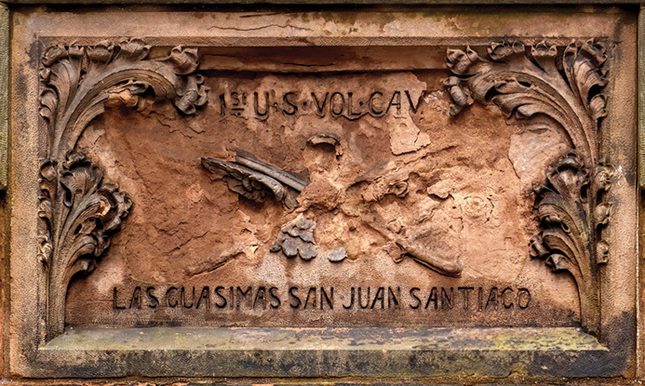
Bob Handelman
Erected by the classmates of Theodore Westwood Miller, Class of 1897, the Old Campus gateway next to Battell Chapel honors his memory with the names of the battles where he fought and died.
View full image

Bob Handelman
Erected by the classmates of Theodore Westwood Miller, Class of 1897, the Old Campus gateway next to Battell Chapel honors his memory with the names of the battles where he fought and died.
View full image

Bob Handelman

Bob Handelman
Over my many years at Yale (nearly fifty, between graduate school and faculty), I never failed to take visiting fellow Cubans to the gateway next to Battell Chapel on Elm Street to show them the word guásimas on its arch. It was astonishing to find such a Cuban word, denoting a well-known tree. When standing inside the Old Campus, next to the chapel, it is not easy to read because it is too high; one has to strain to see it and, next to it, discover a more familiar name, Santiago.
That might have been a clue, but with only the superficial knowledge of the Spanish-American War acquired in our schools, none of us knew that Theodore Roosevelt’s Rough Riders had fought a significant battle against the Spaniards in a grove near Santiago that was known as Las Guásimas because it was full of those trees. Much less did we know that a Yale alumnus from the Class of 1897, Theodore Westwood Miller, fought in that battle; or that he was fatally wounded in another battle shortly after, on July 1, 1898; or that his classmates erected the gateway in his honor.
Today, you can find all this out by searching for “Las Guásimas” on Google, which did not exist during most of my years at Yale, and I am sure that serious historians of the Spanish-American War know all about both battles. When we think of that war, we recall the rout of the Spanish fleet by American warships waiting for them outside of Santiago Bay. Every Spanish ship was sunk as they tried quixotically to steam out of the Bay’s narrow channel past the Americans. But on land, the fighting was more evenly matched and hard fought. Spain had a huge army in Cuba, which had been fighting a sizable Cuban independence force since 1895 with mixed success. The Spaniards were well armed, in some ways better than the Americans. They had powerful German Mauser rifles, more advanced than the Krag-Jorgensen guns in American hands. At Las Guásimas, the fighting was fierce, resulting in an American victory, but hardly a decisive one. Miller survived unscathed, only to be wounded in the Rough Riders’ next skirmish with the Spanish troops, at San Juan Hill. Miller died a week later. He was twenty-three years old.
Had we passed through the arch and gone around to Elm Street, we would have found on the other side of the gateway information about Miller, furnished no doubt by his classmates, and at least some of our queries would have been answered.
The guásima (Guazuma ulmifolia), known in English as the West Indian elm, is a sturdy tree whose pliant wood has been used for many purposes. In Cuba, it has a curious association with death. Despondent Cuban peasants are known to hang themselves from it, and during the War of Independence Cuban forces used it to execute traitors. It has since then been connected with that practice, as is evident in these verses by Cuban poet Juan Marinello:
Cubano, dale tu amor
A quien funda el tiempo nuevo,
y guarda, para el traidor,
guásima, cabuya y sebo.
(Cuban, give your love to those who create the new times, and save for the traitors a guásima, a rope, and grease—to make the nut on the rope slide better.) Even now, those who eagerly anticipate the collapse of the Castro dictatorship allude to the guásimas on which they hope to lynch the regime’s followers. At the eponymous battle, the trees must have served as convenient parapets for both sides. In any case, their proliferation gave the battle its name, which is why it graces the Yale archway on Elm Street.
Born in Akron, Ohio, in 1875, Miller had gone to St. Paul’s School in Concord, New Hampshire. After his Yale graduation he entered New York Law School, and in May 1898, after a year of study, he decided to enlist in the Rough Riders. He traveled to Tampa, Florida, where the troops assembled and trained, and from there to eastern Cuba, around Santiago, where the war was being fought, and where Miller met his death.
 loading
loading